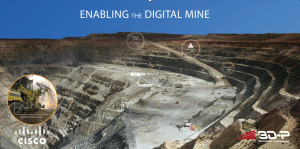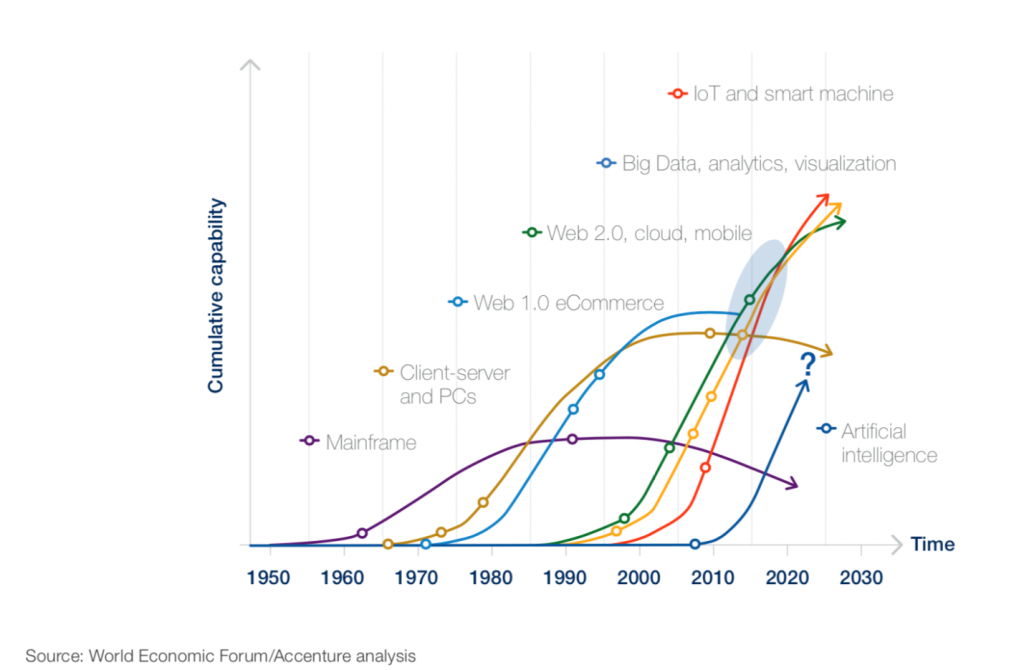
“The mine of tomorrow is not your Father’s Mine.”
Today, robots are an essential part of making automotive plants competitive. In recent years, over half of industrial robot purchases in North America have been made by automakers. Yet a mere decade ago, the idea of leveraging similar technology to develop autonomous mining solutions was science fiction. Digital operations even just a few years ago seemed unlikely for an industry built of fast-followers or laggards, but the new economic realities are driving a new way of thinking.

Nearly a decade since global commodity prices peaked in mining, the industry is facing strong headwinds and is in search of a new identity. The reality is that there are fewer high-quality ore deposits left to develop, and many of those are in harsh and remote locations. Coupled with an aging workforce and poor social license, miners must dramatically rethink how operations of the future are conducted.
Almost every facet of mining operations have the ability to be digitally transformed, and the opportunity over the next decade is massive. How massive? According to a recent World Economic Forum study the industry could achieve close to half a trillion dollars of value, with almost all of the benefits tied to driving down cost per tonne.

From automation and robotics to digitally driven workforces and analytics, digital transformation and the adoption of the Internet of Things (IoT) shows great promise for an industry desperately in need of a makeover. Autonomous and remote operations alone stand to create more than $50b of value. Already industry leaders like Rio Tinto have embraced autonomous haulers, with 76 autonomous vehicles in Rio’s 400-strong truck fleet in Western Australia driving an estimated 15% reduction in cost compared to the non-autonomous haulers. Although cost savings will be the driver for digital mining, the benefits go far beyond. For example, it is estimated that more than 10,000 injuries and 250 fatalities will be avoided over the next decade by these solutions.
So why has an industry struggling with depressed commodity prices for more than a decade been so slow to adopt digital technologies? The answer may lie in the reality that many of the technologies needed for industrial digitization simply did not exist, or were too expensive to make economic sense. The image below shows that many horizontal technologies like IoT, sensors, and analytics simply were not capable a decade ago. But these industrial technologies have greatly benefited from other industries like consumer electronics, aviation, and IT, making them cost effective for mining.
These new technologies rely on vast amounts of data and without a reliable, high performance network they cannot deliver value. That’s why Cisco and 3D-P build cost effective networks for autonomous and remote controlled operations that allow companies to unlock the ROI of the digital mine.
How did we get here?
The mining industry’s thirst for data began with the advent of a number of low network requirement applications over 20 years ago. These applications had low bandwidth needs and drops or outages were a nuisance, but not production-stopping.
These older networks are now being pushed beyond their capacity with the adoption of new high-value core applications with real-time requirements, such as fleet management systems, safety systems, and the increasing use of video and audio over the network. The typical RF principles just don’t cut it in today’s mining.
Several of these applications are now so intertwined with production that network related issues can cause production losses. Today’s mining network is quickly becoming a critical piece of infrastructure that requires careful RF planning, network design, spectrum management, and managed support.
Autonomous Haulage Systems (AHS) are further raising the stakes for reliable wireless infrastructure. These systems represent a step change in the criticality of your wireless network and the spectrum they run on. Any gaps in coverage or issues with latency, jitter, or dropped packets can bring the haul-trucks to a standstill, causing substantial production losses.
So what does it take to implement a successful digital mine?
Enabling the digital mine begins with laying a strong foundation. Using wireless network design best practices, design for the following: a continually changing and evolving environment, to optimize throughput, for the applications, for maintainability, and for the unknown.
Successful implementation of a digital mine will also require a transition from a ‘Connected IoT’ environment to a ‘Smart IoT’ environment. Traditionally in a connected environment, the data is brought to the core via the mine’s wireless network to be analyzed. In a smart IoT environment, the data is analyzed at the edge by an edge computing device, such as the 3D-P Intelligent Endpoint®, which integrates with Cisco routers and switches. This has two benefits for mine operators: first, it significantly reduces the pressure put on the wireless network and network support team, and second, it enables real-time decision making within the mine by improving a device’s ability to self-monitor, self-diagnose, and ultimately self-direct.
Moving most, if not all, of the analytics to the edge provides a greater wireless network ROI as the network can support new applications as they are added, supporting the overall digital mine strategy of your business.
Digitizing a mine in northern Canada for example represents real environmental and technical challenges. With -50c temperatures, massive geographical areas, and little or no network backhaul, successful design, deployment and support of the network is not only critical – it truly becomes the backbone of digital mining, and it’s not easy.
Several inputs need to be considered for the proper design of a mine network. Understanding what existing applications are required to run, while also reviewing the technology roadmap for future needs, provides the base requirements for your network today and moving forward. Once the base requirements are understood, the next step is to understand the geographic and environmental aspects of the mine layout. An analysis of the 10-year mine plan to understand how the mine will progress will achieve this.
The base requirements and an understanding of how the mine will progress are used to conduct a detailed RF analysis and design. Typical Wi-Fi principles just don’t work in a harsh environment like a mine. The strategy for older networks with minimal requirements was to simply put up some access points and make everything high power. The latest applications put new types of requirements on the wireless network. Using the latest technologies is not enough by itself, deployments must consider issues such as contention, congestion, signal propagation, attenuation, proper antenna selection, signal reflection, spectrum usage, spectrum planning, and even the impact from neighbouring sites.
When deploying a new design at a mine site with an older network, the existing technology must be reviewed and a seamless migration plan created to avoid costly downtime. Older technologies such as MotoMesh and early 802.11 networks are end of life and require a transition plan to take the network to new technologies. Proper planning and deployment can make this transition painless.
But there’s good news. By combining Cisco’s extensive global wireless technical capabilities with 3D-P’s extensive mining deployment expertise, even the most challenging remote and autonomous mines can be digitized.
To get started, ask yourself these questions:
• What are your network capabilities today?
• What does your digital mine roadmap look like?
• Do I have the right pieces in place to enable this transformation?
From the continued stagnation of commodity prices, to the reality of the aging workforce, the mining industry needs to re-invent itself as a High-Tech Innovator. Those who wait and rely on past industry cycles may very well become part of mining history, while those that embrace the digital mine of the future may lead the reinvention of the industry.


